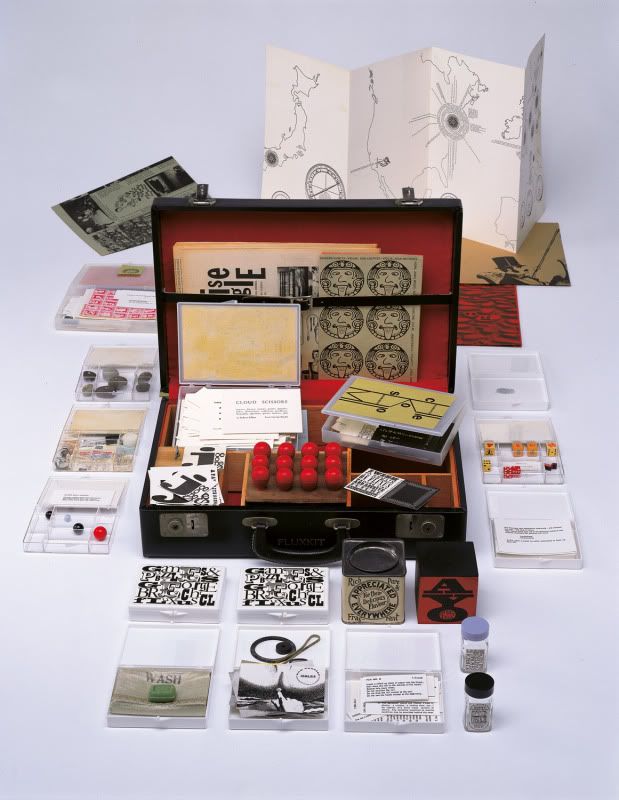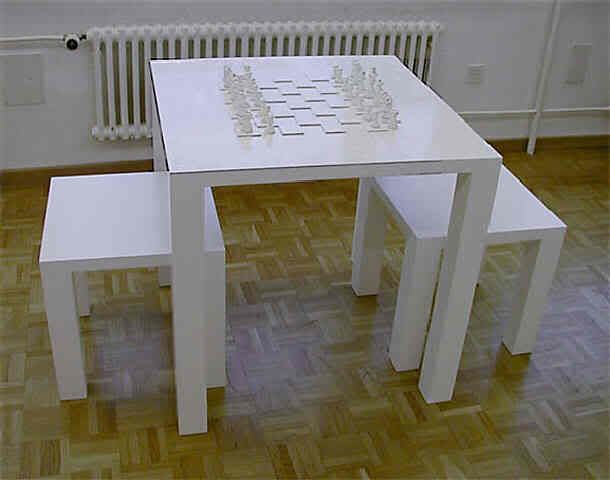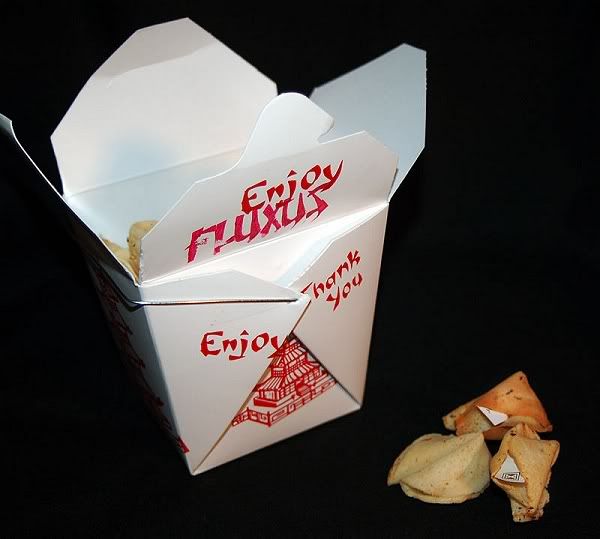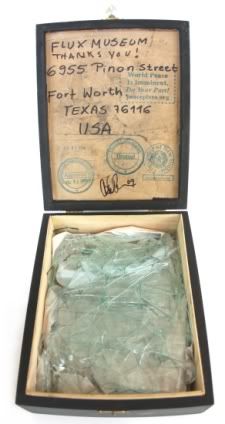Fluxus is an international art movement that began around 1960 in New York and Tokyo and in the European cities of Wiesbaden, Wuppertal, Copenhagen, Paris, Düsseldorf, Amsterdam, the Hague, London and Nice simultaneously. George Maciunas (1931-1978), an American artist of Lithuanian origin who coined the name “Fluxus”, is considered the movement’s founder. Originally the name of his art magazine project, it was used to describe the concerts, festivals, publications and multiples initiated by him worldwide. “Fluxus” is a Latin word meaning “flowing”. Applied to the art movement, it describes a transition in which art flows into everyday life, and also refers to the impermanence of all objects.
 George Maciunas and Robert Watts
George Maciunas and Robert Watts
The format of this box, so character- istic of the Fluxus movement, is based on the principle of chance and interaction between the artwork and the onlooker. It consists of an imitation leather suitcase in which he placed contributions by various Fluxus artists to form an edition.. This work is part of a series of Fluxus boxes developed by George Maciunas and Robert Watts that were to be produced in unlimited editions. They included concepts, events, and games by various Fluxus artists; their content often consisted of found objects. The unbiased use of these works is viewed as the creative point of departure for a new beginning. The found objects assembled here are detached from their conventional use, liberated from the rules assigned to them, and are consequently made available for a new, freely invented game. If playing pieces are lost, they can be replaced with other found objects.
 Gabrielle de Montmollin
Gabrielle de Montmollin
Gabrielle de Montmollin uses a film camera to photograph Barbie Dolls and finger puppets in black and white photographs. Her art is truly impressive and very thought provoking. By limiting herself to using just these materials she is forcing her mind to figure out all of the creative possibilities that can be done with these photography subjects, and has taken her art to a very refined state that couldn't be matched by anyone else with the same materials.
The artist quotes, 'In my photographs I try to suggest interior states which are mirrored in conditions in the world around us. In this series I addressed the theme of physical beauty, its enthrallment, its highs and lows, and its relation to youth, celebrity, consumerism and fantasy.'
 Yoko Ono
Yoko Ono
Yoko Ono is probably the most famous Fluxus artist. Unfortunately she is much better known as the wife of John Lennon than as a leader in the avant garde art of the 1960s.
Yoko Ono's Play it by Trust consisted of a series of installations based on the concept of an all white Chess set. The installations vary in form. In East Hampton, New York, at Longhouse, Ono installed a 16.5 foot square marble and concrete Chess set. There have been a number of small white table and chair sets produced, and an iteration of ten all white sets laid out at a conference table. Ono's Chess modifications represent prime examples of a game—specifically a war game—adapted and utilized as a call for peace. In Play it by Trust, players ultimately lose track of their pieces as their forces move forward. The pieces become lost as "enemies" meet, and, unable to differentiate sides by color, players either must remember where their pieces are, remember the direction their pieces face, or realize that they are all the same. The experience of becoming lost ultimately shows that both sides are equal, forcing players either to follow the standard rules for Chess or to create a new way to play. Here a game that traditionally represents a war is used to show that there are alternatives to fighting, and that when people recognize their similarities, they can find new ways to play, work together, and coexist in peace.
 Keri Marion & Justin Lewis
Keri Marion & Justin Lewis
'47 Years of Good Flux'
The box was a readymade aside from the project-specific hand-carved stamp (Justin Lewis) in mock Chinese lettering marking the word “FLUXUS” twice: once on the side and once on the flap (shown).
Instructions:
1. Take a cookie.
2. Remove Good Fortune.
3. Read Good Fortune
4. Place Good Fortune in Box.
5. Leave cookie outside for Urban Wildlife.
There are exactly 47 cookies and no double fortunes. Each fortune is stamped with a Fluxus X and numbered with the year, 2009.
 Keith Buchholz
Keith Buchholz
Keith is currently one of the most active Fluxus artists around.
Cigar box with a Fluxus Saint Louis postcard attached to the lid. On the inside of the lid collaged shipping material for the Fluxmuseum with post-dogmatist, peaceplaza.org and Fluxus Laboratories stamps. Signed by Cecil Touchon. Contents are a sheet of broken glass from a shipment sent by Buchholz to the Under the Influence show which was damaged during shipping.
No comments:
Post a Comment